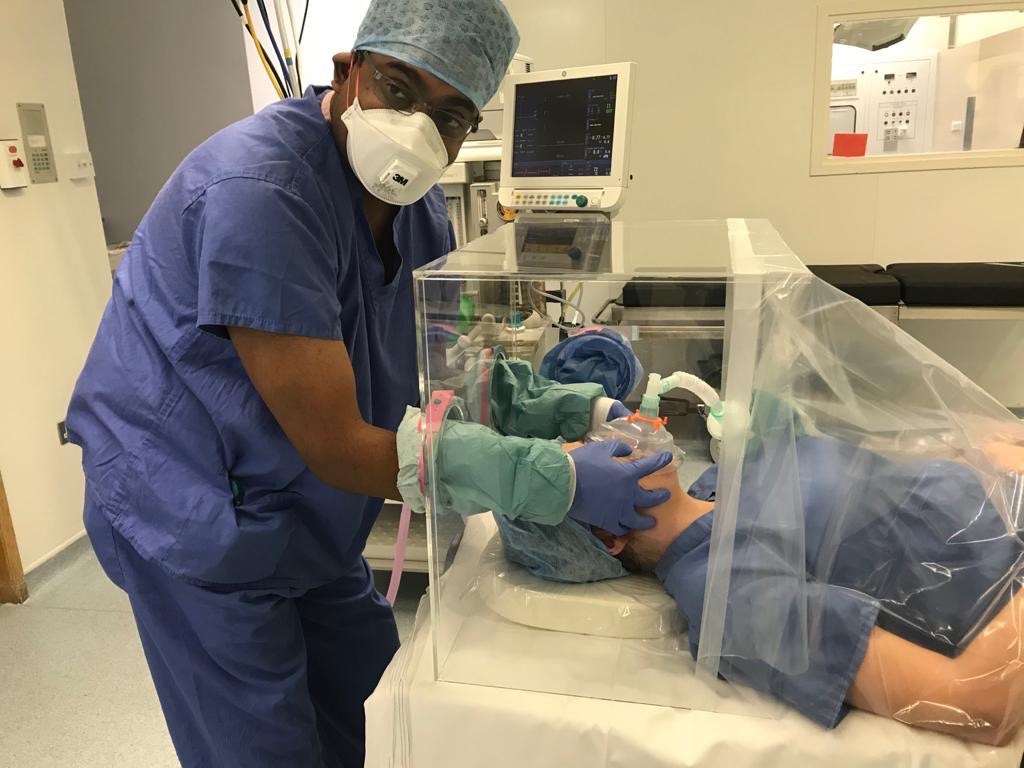As the coronavirus crisis accelerates, so too has the global demand for ventilators in hospitals. Yet key health workers involved in preparing a patient to receive mechanical ventilation are being left severely exposed to infection themselves.

Dr Da Silva trialling an initial prototype at the Royal Orthopaedic Hospital, Birmingham
The requirement for patients to undergo the intubation process where an endotracheal tube (ET) is inserted through the mouth and then into the airway before connecting to a ventilator causes yet another opportunity for the virus to become airborne and infecting those actively involved in the patient’s care. As a result, anaesthetists have been forced to change their standard intubation practices in order to protect themselves from increased virus exposure.
When BBC’s Newsnight Presenter Emily Maitlis posted a Tweet on the 23rd March requesting if anyone in the UK knew how to manufacture an ‘Aerosol Box’ to assist in the care of coronavirus patients, Tim Lightfoot was inspired. Mr Lightfoot, Operations Director at Kesslers, who specialise in manufacturing POS solutions for retailers, immediately started working on scalable production prototypes along with their team.
The solution is a safe intubation and extubation barrier that is being dubbed “DAB Hands”. A simple foldable, transparent cabinet to be placed over a patient’s head, it has two holes on the front and one on each side through which physicians can insert their protected hands to perform the procedure while being shielded from the patient’s respiratory droplets. It simultaneously enables an anaesthetist to perform endotracheal intubations and the patient to breathe whilst protecting health care personnel from aerosol exposure of airborne CoVid-19.
Unknown to the Kesslers team at the time was that Dr Chandra Bhimarasetty, a Consultant Anaesthetist at the Royal Orthopaedic Hospital, Birmingham had also begun turning his own living room into a make-shift workshop and spent three long nights without sleep trying to refine the design into a collapsible and disposable barrier that wouldn’t just protect himself, but those of his fellow workers across the NHS.
Based on their separate developments, Mr Lightfoot and Dr Bhimarasetty were introduced via the Coventry and Warwickshire Growth Hub and formed a partnership along with Dr Egidio Da Silva of the Royal Orthopaedic Hospital, Birmingham and Matt Campbell-Hill, Senior Fellow Institute of Clinical Sciences in Birmingham, who has provided clinical and design concept advice.
“In the current crisis we need every little modification to help protect NHS staff,” says Dr Bhimarasetty, “because apart from being doctors and nurses, we are also partners and parents.”
Together they further refined the concept and created an aerosol barrier that is lightweight, collapsible, flat-packed, easily assembled and with integrated gloves – with one simple, important fact; this is a single-use disposable item. It negates the need for the requirements to disinfect between patients; offering less infection risk from any potential cross-contamination and in turn, serves to speed up the ability to provide time-sensitive care for those requiring ventilation. The one-piece barrier is also an environmentally friendly solution and the compact fold-away design makes it easy to slip into a clinical waste bag for disposal after use.
“Kesslers have a proud history of supporting national emergencies, from making parts for the war effort to turning our skills to combatting the spread of Coronavirus. Using our background in manufacturing global retail and POS solutions, we have immediately been able to adapt our business; first supporting retailers with protective Sneeze Screens to enable the ‘Feed the Nation’ campaign then in this latest quest to help protect frontline NHS workers. The innovation in the Disposable Aerosol Barriers alongside PPE visors has been a great achievement from the team and we are proud and honoured to see them in use, saving the lives of our NHS heroes,” says Mr Lightfoot.
Initial trials with the Disposable Aerosol Barrier are being heralded as a breakthrough in providing necessary care. Not only is this new solution safer for the health care worker, as it keeps them away from the patient’s infection, but it allows the anaesthetist to be able to use standard intubation procedures – at leisure rather than haste. Furthermore, it is far more comfortable for the patient who can now remain ventilated during the procedure, whilst minimising any feeling of claustrophobia.
With a recent report from Imperial College London estimating that 30% of Covid-19 hospitalised patients are likely to require mechanical ventilation, this in turn will require more patients needing to undergo intubation, putting medical personnel at increased risk as medical resources such as air-purifying respirators and N95 masks are continually depleted. It is therefore now more than ever important to protect our health workers and in turn the NHS’s ability to cope.
The Disposable Aerosol Barrier is meant to work in conjunction with and not instead of any standard-issue PPE. However, this cross-discipline team pulling together experience from the private sector with the NHS hopes to turn every health care worker involved in administering vital ventilator support into ‘DAB hands’ – and most importantly, save lives.
With the new design now seeking to become patented, “its impressive how we’ve all pulled together in such a short space of time,” says Dr Da Silva, “and it makes me proud to be British.”

